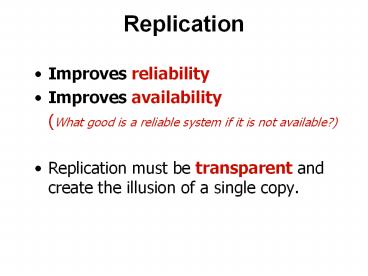Replication PowerPoint PPT Presentation
Title: Replication
1
Replication
- Improves reliability
- Improves availability
- (What good is a reliable system if it is not
available?) - Replication must be transparent and create the
illusion of a single copy.
2
Updating replicated data
shared
Separate replicas
F
F
F
Alice
Bob
Bob
Alice
Update and consistency are primary issues.
3
Passive replication
- At most one replica can be the
- primary server
- Each client maintains a variable L
- (leader) that specifies the replica to
- which it will send requests. Requests
- are queued at the primary server.
- Backup servers ignore client requests.
4
L3
1
3
L3
primary
2
clients
backup
4
Primary-backup protocol
- Receive. Receive the request from the client and
update the state if appropriate. - Broadcast. Broadcast an update of the state to
all other replicas. - Reply. Send a response to the client.
client
req
reply
primary
update
backup
5
Primary-backup protocol
- If the client fails to get a response due
- to the crash of the primary, then the
- request is retransmitted until a
- backup is promoted to the primary,
- Failover time is the duration when
- there is no primary server.
New primary elected
client
req
reply
primary
update
?
heartbeat
backup
election
6
Active replication
- Each server receives client requests, and
broadcasts them to the other servers. They
collectively implement a fault-tolerant state
machine. In presence of crash, all the correct
machines reach the same next state.
input
Next state
State
7
Fault-tolerant state machine
- This formalism is based on a survey by Fred
Schneider. - The clients must receive correct response even if
up to - m servers fail (either fail-stop or byzantine).
- For fail-stop, (m1) replicas are needed. If a
client - queries the replicas, the first one that responds
gives a - correct value.
- For byzantine failure (2m1) replicas are
needed. m - bad responses can be voted out by the (m1) good
- responses.
Fault intolerant
Fault tolerant
8
Replica coordination
client
- Agreement. Every correct replica receives all the
requests. - Order. Every correct replica receives the
requests in the same order. - Agreement part is solved by atomic multicast.
- Order part is solved by total order multicast.
- The order part solves the consensus problem
- where servers will agree about the next update.
- It requires a synchronous model. Why?
server
9
Agreement
client
- With fail-stop processors, the agreement part
- is solved by reliable atomic multicast.
- To deal with byzantine failures, an interactive
- consistency protocol needs to be implemented.
- Thus, with an oral message protocol, more than
- 3m processors will be required.
server
10
Order
- Let timestamps determine the message order.
client
A request is stable at a server, when the it
does not expect to receive any other client
request with a lower timestamp. Assume three
clients are trying to update a data, the channels
are FIFO, and their timestamps are 20, 30, 42.
Each server will first update its copy with the
value that has the timestamp 20.
30
20
server
42
11
Order
- Let timestamps determine the message order.
client
But some clients may not send an update. How
long should the server wait? Require clients to
send null messages (as heartbeat signals) with
some timestamp ts. A message (null, 35) means
that the client will not send any update till
ts35. These can be part of periodic hearbeat
messages.
30
null
35
server
42
12
What is replica consistency?
replica
clients
Consistency models define a contract between the
data manager and the clients regarding the
responses to read and write operations.
13
Replica Consistency
- Data Centric
- Client communicates with the same replica
- Client centric
- Client communicates with different replica at
different times. This may be the case with mobile
clients.
14
Data-centric Consistency Models
- 1. Strict consistency
- 2. Linearizability
- 3. Sequential consistency
- Causal consistency
- Eventual consistency (as in DNS)
- Weak consistency
- There are many other models
15
Strict consistency
- Strict consistency corresponds to true
replication transparency. If one of the processes
executes x 5 at real time t and this is the
latest write operation, then at a real time t gt
t, every process trying to read x will receive
the value 5. Too strict! Why?
W(x5)
p1
R(x5)
p2
t
t
16
Sequential consistency
- Some interleaving of the local temporal order of
events at the different replicas is a consistent
trace.
W(x100)
W(x99
R(x100)
R(x99)
17
Sequential consistency
- Is sequential consistency satisfied here?
Initially x y 0
W(x10)
W(x8
R(x10)
W(x20)
R(x20)
R(x10)
18
Causal consistency
- All writes that are causally related must be
seen by every process in the same order.
W(x10)
W(x20)
R(x10)
R(x20)
R(x10)
R(x20)

